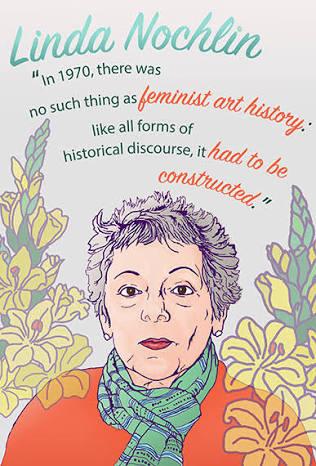Linda nochlin, the perspicacious art historian who was known for her study, teaching, and exhibition of art, reshaping her field has died at the age of 86.

The Art Historian Linda Nochlin
In 1971, Nochlin earned widespread attention for her landmark essay on “Why Have There Been No Great Women Artists?,” demonstrating how, for centuries, institutional and societal structures had made it impossible for women to achieve artistic excellence, or success, on the same footing as men, no matter what the potency of their so-called talent, or genius is. That article quickly became a cornerstone for the developing field of feminist art history. It would have been enough to secure her place as one of art history’s most important writers, but over the course of her six-decade career, she also made formidable contributions to the study of Realism and Gustave Courbet, Impressionism and Post-Impressionism, and numerous contemporary artists.

Linda Nochlin Artworks
Nochlin was born Linda Weinberg on January 30, 1931, in Brooklyn. She lived near Ebbets Field and whenever the Dodgers made a home run all the ornaments on the mantelpiece shook from the wild applause. She once told the scholar Maura Reilly, who edited a 2015 anthology of Nochlin’s writing about it. She attended cultural events throughout the city regularly when she was growing up, and she later went to college in upstate New York, at Vassar College in Poughkeepsie, from which she graduated with a degree in philosophy, minoring in both Greek and art history in 1951,according to the Dictionary of Art Historians. Two years later, she married the professor Philip H. Nochlin, and they had a daughter Jessica. Her husband died in 1960.
After completing a masters in english at columbia University in 1952, she went to New York University’s Institute of Fine Arts to complete her doctoral work in art history. It was during the McCarthy period that she came to maturity was what she told an interviewer earlier this year. Then she went to the Institute where she really wanted to work on something that was anti-McCarthy. That was left. She was a person of the left and Courbet was the ideal subject in that. Her writings about the French Realist artist homed in on his representations of the working class and women, and in 1988 she co-curated a widely lauded retrospective of his work at the Brooklyn Museum, which included the first public display of his book “The Origin of the World” since its creation in 1866.

Remembering the pioneering Feminist Artist
Nochlin said that when she began writing “Why Have There Been No Great Women Artists?” in 1970, she had recently become deeply involved with feminist issues. Two years earlier, she had married the architectural historian Richard Pommer, and they had the artist Philip Pearlstein paint a double-portrait of them as newlyweds. In 1993, in Artforum, Nochlin wrote of that work, “Flatness, abstraction, formalism, patriarchy, racism, cultural authority of every kind: the doctrines of Modernism were never accepted so unquestioningly again. The portrait, for me, was part of the end to the simple acceptance of what art was about and had to be. The next year, women’s liberation made its dramatic entry, with a whole new set of revolutionary rejections and innovative projects, including the women’s movement in art.”
Thinking back to the time she wrote her most famous piece, she once told Reilly that “there was no such thing as a feminist art history: like all other forms of historical discourse, it had to be constructed. New materials had to be sought out, a theoretical basis put in place, a methodology gradually developed.”
Nochlin was beloved by many artists, and many painted her, including Alice Neela work that also includes the art historian with Daisy, her daughter with Pommer , Deborah Kass, and Kathleen Gilje. Kass painted her in 1997 in the style of a Warhol “Death and Disaster” work, repeating Nochlin’s face a dozen times along a 10-foot-tall orange canvas. “This would be called Orange Disaster by Linda Nochlin, because what else could you call the woman who changed art history as I and all before me had learned it?” Kass later wrote. “Who else had undermined the very ground upon which it had been built? Who, besides Linda Nochlin, struck the first and fiercest blow against the white male canon?

Thank you for being a Feminist Hero
Frank Jewett Mather Prize for Critical Writing, Nochlin wrote prolifically. Her books include Realism (1971), Women, Art, and Power, and Other Essays (1988), The Politics of Vision (1991), The Body in Pieces: The Fragment as a Metaphor of Modernity (2001), and Bathers, Bodies, Beauty (2006). Another volume, about how misery is represented in England and France in the latter half of the 19th century, is scheduled to appear next spring. Her academic writing exhibits a rare ability to present both intense research and theory in accessible ways, and she was also wry, witty, and experimental when it came to writing.
In addition to the 1988 Courbet retrospective, Nochlin organized other seminal shows, like “Women Artists at the Los Angeles County Museum of Art, wand “Global Feminisms: New Directions in Contemporary Art,” Sackler Center for Feminist Art in 2007. Nochlin also taught regularly, retiring as a professor of modern art at NYU’s Institute of Fine Arts in 2013.
In 1989, nearly two decades after the publication of “Why Have There Been No Great Women Artists?,” Nochlin was asked by the Vassar Quarterly about the kind of responses her writing had generated. She said that most had been extremely enthusiastic and positive, though she noted that some people had been threatened by her work. She does a lot of traveling and lecturing, which she enjoy very much and sometimes she gives as many as 12 lectures in a year, both here and abroad. She welcomed the chance to travel around the world, talking to people and gathering responses, many of which she later incorporate into her work.
Linda was quoted as saying, “I feel that in some sense, all my work is provisional while I believe in it very strongly, I still remain open to what I hear, learn, and experience. Linda Nochlin a prolific artist to be remembered.



What do you think?